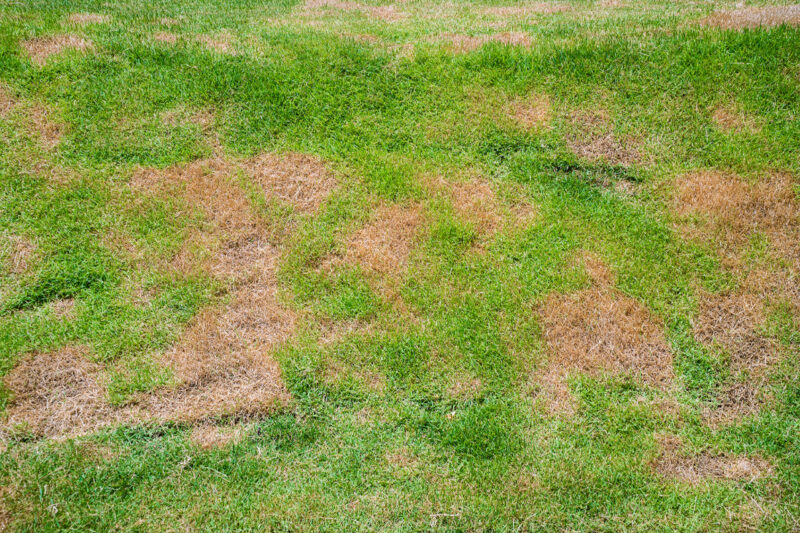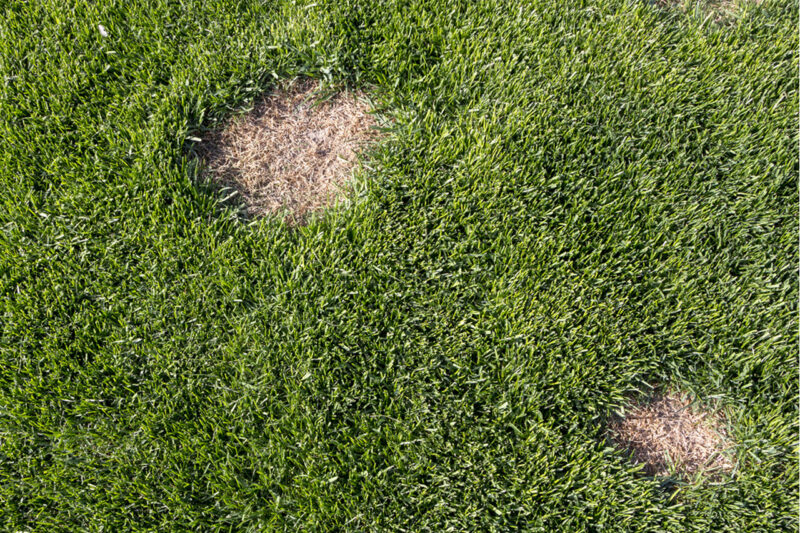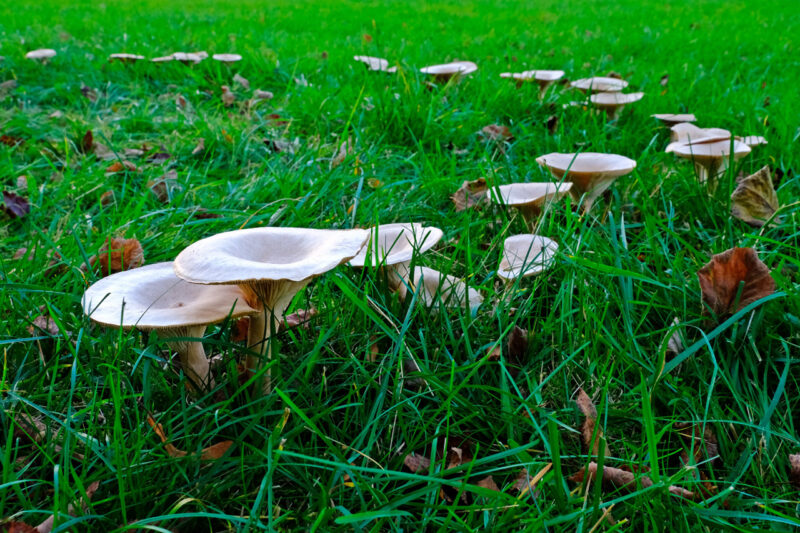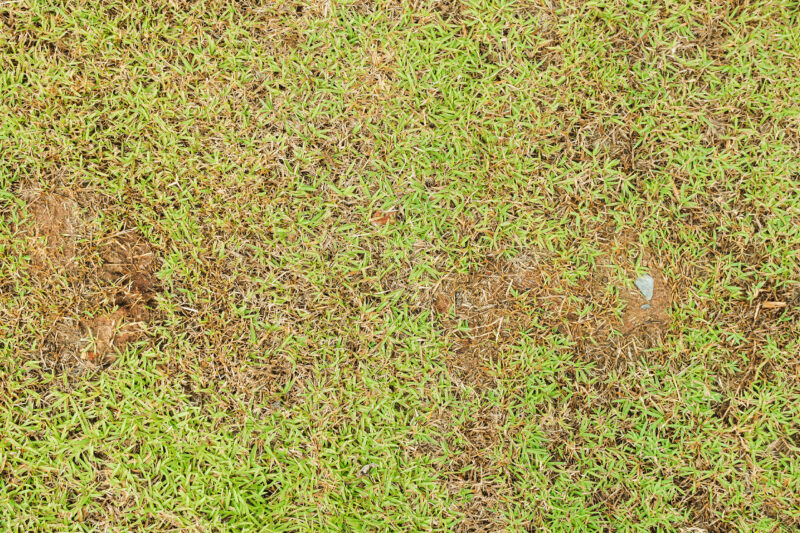
Are you tired of seeing brown patches or unhealthy grass ruin your well maintained lawn? When you don’t identify and treat lawn diseases, they can damage your grass long-term. As a landscaping company in Wichita, KS, Elite Landscape Solutions developed this guide to help homeowners identify and treat common lawn diseases in Kansas.
Brown Patch (Rhizoctonia Solani)

Symptoms
Circular brown patches are a telltale sign of brown patch (Rhizoctonia Solani) disease. These patches are often the disease themselves. As the name suggests, brown patch disease discolors grass and typically creates a muted olive green or brown patch on lawns. After the infection takes hold, leaf blades turn brown and you may also see white streaks or bands around the patches.
Causes:
A fungus called Rhizoctonia Solani causes brown patch disease in cool-season grasses and turf grasses. The fungus thrives during hot, humid conditions in the summer, which activate the pathogen the fungus carries. Lawns with high nitrogen are also more susceptible to the fungus because the nitrogen-rich soil feeds the pathogen, leading to a more severe outbreak.
Treatment:
You can start treating brown patches by improving airflow and circulation around affected areas. This involves raking the soft, spongy thatch or using aeration to create small holes to promote airflow. Improving circulation helps prevent the pathogen from spreading to healthy grass. Applying fungicide is another effective way to treat the problem. However, we recommend contacting a professional landscaper to make sure you choose the correct treatment. Lastly, make sure not to overwater or over fertilize as both of these can strengthen the pathogen.
Prevention:
Preventing and treating brown patch disease involve similar strategies. You can reduce the chances of infection by improving air circulation and avoiding overwatering. Other methods like properly mowing help you catch the disease early and stop fungal buildup near the soil. Fertilizing in the spring and fall is another great rule of thumb, this stops the fungus from growing during damp periods and keeps your lawn healthy.
Dollar Spot (Sclerotinia Homoeocarpa)

Symptoms:
The most common symptom of dollar spot disease is the appearance of small circular patches of straw-colored grass. These dollar spot patches may seem sunken or depressed compared to the rest of the lawn. Leaf blades in the patches may also have lesions surrounded by reddish-brown borders.
Causes:
Like other types of lawn diseases, dollar spot is caused by a fungus that takes hold and grows through extended periods of dew and high temperatures. However, this one produces no spores and it spreads through movement of infected leaf blades. As a result, mowing and turf maintenance may spread the fungus to new areas. Poor turf maintenance, and nitrogen deficient turf are typically the root cause of dollar spot disease.
Treatment:
Treating dollar spot disease is relatively straightforward. In most cases, fungicide application is not necessary. Instead, focus on providing nitrogen-balanced care and watering during the early morning and at night. You may also want to try aeration to help increase the amount of nutrients the lawn absorbs.
Prevention:
Proper lawn care helps prevent dollar spot disease. We recommend practicing proper irrigation techniques that water your grass deeply to prevent fungi from growing. Another useful prevention tactic is dethatching. This helps reduce moisture build up, improves air circulation and allows more nitrogen to reach the grass roots. Last but not least, make sure to mow at the appropriate height. Do not cut more than ⅓ of the grass at a time and mow your grass at the height recommended for your grass type.
Fairy Ring

Symptoms:
Fairy ring disease is easy to spot on home lawns. The most obvious sign of fairy rings are irregular circles of dark green grass. The circles or arcs may be made of dead grass and can span from a few inches to hundreds of feet in size. While the rings may look similar to each other, they have different levels of impact. In general, there are three types of fairy rings.
Type one – Can kill grass if left untreated and may damage your lawn over time
Type two – Generally harmless, may only cause changes in appearance. Type two will typically promote grass growth, creating dark green grass circles.
Type three – Also harmless, but does not promote growth. Type three will instead produce mushroom rings.
Causes:
Fairy rings are also caused by a fungus. Poor fertilization and irrigation cause the rings to spread and grow. The fungus also tends to grow in areas where organic matter is decaying or decomposing. Trees, lumber and other matter buried underground can promote fungi growth and further increase the severity of the rings.
Treatment:
Treating fairy ring disease involves several different methods. Homeowners can mask or suppress the symptoms by applying nitrogen rich fertilizer and using deep watering techniques. However, to fully eradicate the disease homeowners need to carefully remove the contaminated soil, place new soil and then reseed the affected areas.
Prevention:
Good lawn sanitation and proper fertilizing keeps your lawn strong and healthy, reducing fungal spores in the soil. For example, removing decaying organic matter like dead trees, grass clippings or organic debris stops the fungus from feeding and reduces the likelihood of infection. For further protection, consider applying fungicides in the spring and fall to help fight off fairy ring disease.
Red Thread (Laetisaria fuciformis)

Symptoms:
You can easily notice red thread disease from a distance because it creates pink or reddish circular patches on lawns. This disease does not impact the health of the grass; however, it changes the look of your lawn by creating red, thread-like strands from the tips of infected leaf blades. The patches typically appear on lawns during the spring and fall and range from 4 to 8 inches to several feet in diameter.
Causes:
Red thread disease is caused by a fungus called Laetisaria Fuciformis, which commonly results from poor nutrition. The fungus most often affects low nitrogen soil and slow-growing turf species, especially temperatures from 40°F-75°F, making it more common during the spring and fall.
Treatment:
We do not recommend strong chemical treatments or fungicides for red thread disease. Using harsh chemicals may further hurt the lawn if not applied properly. Instead, treatment should include a balanced, nitrogen rich diet. Over time, this approach creates a stronger, more resilient lawn, reducing the risk of infection and promoting healthy growth.
Prevention:
Long-term red thread prevention looks a lot like treatment. We recommend using best lawn care practices and focusing on the health of your lawn. Nitrogen-balanced fertilizers, aeration and dethatching are all great places to start. All three options remove moisture buildup, promote nitrogen and fertilizer intake and increase airflow, discouraging fungus growth.
Additional Tips for Preventing Lawn Diseases
Watering: One of the best ways to take care of your lawn and prevent disease is proper irrigation. Deep, infrequent watering keeps the soil near the roots of the grass moist and encourages deeper root growth, making the grass more resilient to disease. This watering technique also reduces the moisture on the leaf blades, preventing disease growth on the blades, which could spread throughout the lawn.
Mowing: Mowing grass at the correct height can help by reducing stress on your grass, making it more resilient to infection. Additionally, appropriate mowing encourages new growth and strengthens the existing turf.
Fertilization: Balanced fertilization plays a vital role in protecting your healthy lawn from disease. Fertilizer helps make up for deficiencies in your lawn, which is important for preventing diseases like dollar spot and red thread.
Aeration & Dethatching: Both aeration and dethatching address two major causes of lawn disease: soil compaction and thatch buildup. Reducing soil compaction allows water, nutrients and air to reach the roots of the grass and promotes stronger root growth. Dethatching removes the layer of dead and decaying organic matter at the base of the grass, which helps prevent fungi from infecting your lawn.
Professional Lawn Disease Treatment & Prevention in Wichita, KS
Whether you are fighting brown patches or looking to prevent other common lawn diseases, Elite Landscape Solutions in Wichita is here to help. Our team of lawn care experts can diagnose, treat and prevent lawn diseases common in Kansas, helping you get your lawn back on track.
